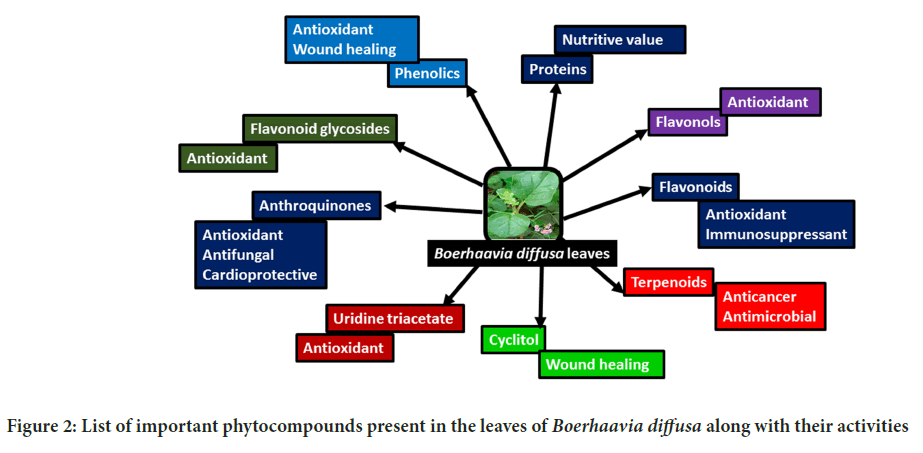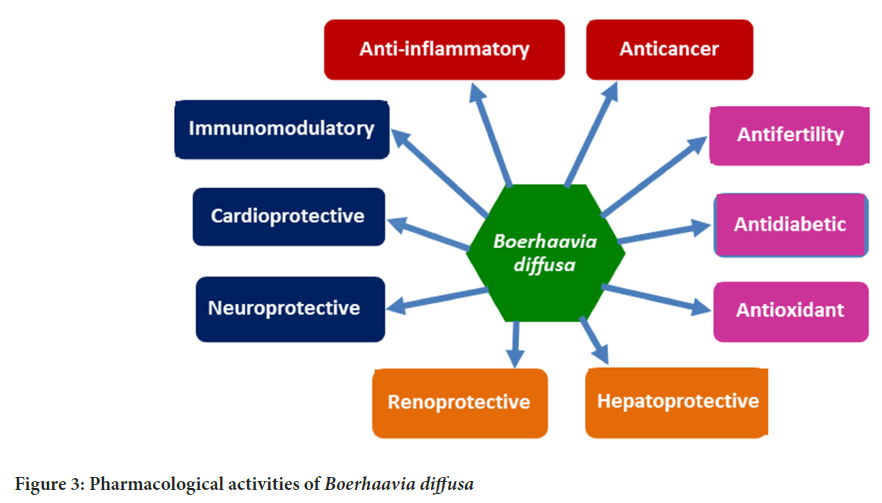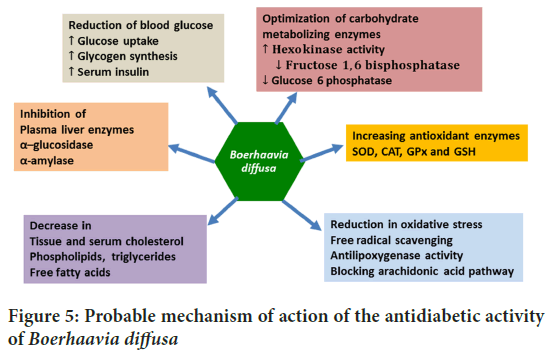Review Article - (2023) Volume 14, Issue 8
Vivid Phytochemical and Pharmacological Evaluations of Boerhaavia diffusa L.: An Omnipotent Natural Healer
Sarita Das1*, Biswa Mohan Sahoo2 and Subrat Kumar Bhattamisra3Abstract
The spreading Hogweed or Boerhaavia diffusa L. (BD) is a potent herbal medicine with diverse pharmacological activities. In Asia and Africa, it is used in different Ayurvedic medicines as a rejuvenator or “Rasayan” for its excellent antiaging and antioxidant properties. This review is intended to provide an extensive study on different phytochemicals present in BD and their relevant pharmacological activities to support its ethno medicinal uses. Further, this may help in exploring the undiscovered active constituents of BD, responsible for its diverse pharmacological uses. The data from different published research and review arti cles, confined to phytochemistry and pharmacological activities of different parts of BD, were extracted by using specific keywords from different scientific databases like Google, Science Direct, PubMed, etc. The whole plant (root, stem, leaf, flower and fruits) is rich in different bioactive phytocompounds. Till date, many of them were isolated from the roots and other parts of BD, but the most important secondary metabolites are phenolics, rotenoids, flavonoids, isoflavonoids, alkaloids, steroids, anthracenes and lignans. The crude extracts and the purified compounds were reported to have promising activities like antimicrobial, antioxidant, anticancer, anti-inflammatory, immunomodulatory, antidiabetic, hepatoprotective, renoprotective, cardio protective, antifertility etc. As the reports on molecular mechanisms of specific interaction between isolated compounds and microbial effector proteins/toxins or their interference with molecular pathogenesis are limited, further investigation can be carried out to understand the prophylactic and therapeutic role of these phytomolecules in different diseases at a molecular level using appropriate experimental models.
Keywords
Antimicrobial, Antidiabetic, Anticancer, Boerhaavia diffusa, Flavonoids, Phenolics Punarnavine, Renoprotective
Introduction
Boerhaavia diffusa L. (BD) (family: Nyctaginaceae) is also known as spreading Hogweed or Punarnava that means renewer or rejuvenater of the body because of its antiaging property (Wahi AK, et al., 1997). It is a perennial, prostrate herb with pink flowers and sticky fruits. Its old root stock remains dormant during summer and regenerates in the rainy season. Different parts of BD are rich in diverse bioactive compounds and extensively used as a “rasayan” for its outstanding properties like immunity booster, reestablishing youth and strengthening body and mind. Oxidative stress (resulted due to an imbalance between reactive oxygen species (oxidant) production and their utilization) is often associated with many diseases i.e. dementia, Parkinson’s disease, Alzheimer’s disease, heart attack, myocardial infarction and other age-related diseases (Cadet JL, 1988; Demopoulos HB et al., 1980). The promising antioxidant activity of BD is responsible for its varied pharmacological activities. BD root and its aerial parts are rich in alkaloids, phenolic compounds, flavonoids, terpenoids, saponins, lignans, sterols, purine nucleosides, anthraquinones as well as many fatty acids and proteins, which contribute to its tremendous bio potentiality. Therefore, the present review is prepared to compile the antimicrobial and other pharmacological activities of BD in order to validate and support the ethno medicinal uses that would be beneficial for researchers as well as for common people. In this review, we had tried to compile and redraft all the known phytochemicals and pharmacological activities of BD for easy reference.
Literature Review
Methods
Extensive search for review of literature on the ethno medicinal, antimicrobial, pharmacological properties of BD and its different parts was conducted by using different websites like Google, Scopus, Sci-Hub, SciFinder, PubMed and Science Direct etc., using different key words like antibacterial, antifungal, anticancer, anti-inflammatory, hepatoprotective, cardio protective, renoprotective, antidiabetic, antifertility activities of Boearhaavia diffusaand its root, leave, stem etc. Both research and review articles were studied and compiled in this review.
Ethnomedicinal uses
Punarnava or BD has a bitter taste and cooling nature. As per its name, it renews the whole body. A person gains vigor and vitality with its routine use. It has emetic, expectorant, stomachic, diaphoretic, laxative and diuretic property (Nadkarni K, 1976). BD is extensively used as a rejuvenator in various ayurvedic formulations not only in India, but also worldwide especially in Asia, Africa and Latin America for its tremendous therapeutic potential against various diseases such as epilepsy, abdominal pain, diarrhea, dysentery, urinary and kidney problems, pneumonia, jaundice, anemia, splenomegaly etc. It is a well-known tonic, blood purifier, uterine bleeding preventor used to check post-partum hemorrhage. It is beneficial in wound healing and skin problems like itching and eczema (Agrawal B, et al., 2011). It improves digestion and maintains healthy body mass index and prevents anemia, hernia and respiratory distress. The root extract is a potential heart, kidney and liver stimulant. It protects kidneys that are damaged due to diabetes. It is useful in asthma, constipation, cough and detoxification of body because of its diuretic, renoprotective and laxative property. It is used against dropsy, ascites, swelling of legs, gonorrhea, intestinal worm infestation, jaundice and other liver complications. It relieves from inflammation and joint pains, boosts immunity and strengthens lungs. Root paste is used as a miraculous dressing for ulcers and swellings. It is beneficial in nerve flaws, paralysis and also used in treating fever and improving appetite (Bhowmik D, et al., 2012). In case of ascites, liver cirrhosis is usually followed by congestive heart failure and herbal diuretics are preferred to correct the abnormal fluid dynamics of the body. Whole leaves or its formulations are taken orally or applied locally for wound healing or to cure scorpion sting and snake bite as they have anti-inflammatory properties (Mishra S, et al., 2014).
Pharmacological activities
Antimicrobial activities of B.diffusa: The different extracts of BD had been reported to have significant antibacterial, antifungal, antiparasitic and antiviral activities (Samy RP, et al., 1999). Antibacterial activities of alcohol and chloroform extracts of BD were studied against six bacteria viz. Escherichia coli, Staphylococcus aureus, Salmonella typhimurium, Proteus mirablis, Klebsiella pneumoniae and Pseudomonas aeruginosa.Benzene: Ethyl acetate (4:1) fraction of chloroform extract was found to be effective against S. typhimurium, E. coli and P. aeruginosa whereas, n-butanol fraction of alcohol extract was found to be effective against S. typhimuriumand P. mirabilis(Gopal H, et al., 1999). BD leave extract was tested against various Gram positive (Bacillus subtilis, S. aureus, Streptococcus faecalisand Micrococcus luteus) and Gram negative (E. coli, Shigella flexneri, Vibrio cholera, Salmonella typhi, P. aeruginosa, K. pneumoniae, Serratia marcescens and Proteus vulgaris) human pathogenic bacterial strains by measuring the Zone of Inhibition (ZOI). It was observed that chloroform, ethylacetate, methanol, ethanol and aqueous extracts were effective against these bacteria. The ethanol extract of BD leaves revealed better efficacy against S. aureus(ZOI=11 mm) and E. coli (ZOI=9 mm) when compared to other extracts (Umamaheswari A, et al., 2010). The methanol, ethyl acetate and n-hexane extracts of BD aerial part (at 1000 µg/disc concentration) showed remarkable antimicrobial activity against S. aureus, S. dysenteriaeand Candida albicans(Apu AS, et al., 2012). In another study, different plant parts (root, stem and leaf) of BD were investigated for their antibacterial property. Among all the plant parts, the root extract at higher doses (200 and 100 mg/mL) exhibited marked activity with ZOI=12 to 16 mm against S. aureus, whereas at lower doses (50 and 25 mg/mL), leaf extract showed better response among other extracts with ZOI of 13 to 11 mm against S. aureus. Further, root extract was also effective against S. typhiwhereas, none of the extracts was effective against E. coli(Majgaine S and Verma DL, 2017), which contradicts the findings of other researchers. In addition to these common human pathogenic bacteria, BD was also reported to be effective against Ehrlichia canis, the causative agent of Canine Monocytic Ehrlichiosis (CME). BD was used in a polyherbal preparation containing Guduchi (Tinospora cordifolia), Ashvagandha (Withania somnifera), Shatavari (Asparagus racemosus) and Methika (Trigonella foenum-graecum) that was tested in dogs with CME and compared with doxycyclin. Significant improvement in vital parameters was observed in both groups, which proved the potency of this polyhedral immunomodulatory preparation in infected dogs (Bai L, et al., 2019).
Ethanol, ethyl acetate, chloroform and petroleum ether extract of aerial parts and roots of BD were tested for their antifungal activity against dermatophytic fungi Microsporum gypseum, M. canis and M. fulvum by using broth dilution method. The ethyl acetate extract of root showed maximum efficacy against all the fungal strains whereas, all the extracts of aerial part did not show any visible effect. The maximum inhibition of mycelial growth by ethyl acetate extract of root (1000 µg/mL, 24 h incubation) was 78.83%, 62.33% and 42.30% against M. gypseum, M. fulvum and M. canis, respectively. This study suggested the presence of antifungal phytoactive constituents in the roots of BD (Agrawal A, et al., 2003). In addition to these four solvents, aqueous extracts of aerial parts and roots of BD were tested against M. fulvum. The inhibition (%) of different extracts of root at 5000 ppm for 10 days was determined as 26% (chloroform), 46% (ethyl alcohol) and 57% (ethyl acetate) against M. fulvum. Ethyl acetate extract showed maximum percentage of inhibition as compared to other extracts. Further, on increasing the concentration of the phytoextract, the colony diameter is reduced proportionately, suggesting its potential antifungal activity (Agrawal A, et al., 2004).
The methanol extract of BD root was tested for its antiplasmodial activity against chloroquine resistant strain (Plasmodium bergheiNK 65) using suppressive, curative and prophylactic malaria models in male and female albino mice. BD (125 mg/kg) exhibited best antipyretic effect at day 3 of suppressive model and this relates to its antimalarial activity. BD (500 mg/ kg) reduced the plasma Ca2+ level better than nifedipine (positive control) i.e. 1.043 mmol/L vs.1.35 mmol/L. Its efficacy in reducing pyrexia, induced by malaria through blocking the Ca2+ channel in the erythrocytes, supports its use in treating fever. The result of this study certifies its usefulness in treating malarial infection as claimed by the folklore (Adefokun DI, et al., 2015).
The antileishmanial activity of BD and Ocimum sanctumwas evaluated in Leishmania donovani infected BALB/c mice model. Maximum parasite clearance from the infected animals was reported at the combination therapy of BD (100 mg/kg) and O. sanctum (400 mg/kg) for 5 days. Cell-mediated immunity was also up-regulated in extract treated groups with increased delayed type hypersensitivity responses and increased Immunoglobulin G2a (IgG2a) levels. Further, the extract treatment brought down the elevated serum urea, Blood Urea Nitrogen (BUN), serum Creatinine (Cr), Serum Glutamic Oxaloacetate Transaminase (SGOT) and Serum Glutamic Pyruvate Transaminase (SGPT) levels to normal (Kaur S, et al., 2015). The reports, published between the year 2000 to 2020 on the antibacterial, antifungal and antimalarial activities of BD, were compiled in Table 1.
| Doses | Model used | Major findings | References |
|---|---|---|---|
| Antibacterial activity | |||
| Aqueous and methanolic extracts of BD | Human pathogenic bacteria | Significant antibacterial activity was detected against Bacillus cereus, B. subtilis, E. coli, Klebsiella sp., P. mirabilis, P. aeruginosa, S. typhi, Shigella sp., S. aureus and Yersinia enterocolitica at 50 μL of extract. However, no Minimum Inhibitory Concentration (MIC) value of the extract against each bacterium was determined. | Girish HV and Satish S, 2008 |
| Ethanolic and aqueous extracts of BD | The MIC of ethanolic extract=125 and 250 μg/mL and aqueous extract=250 μg/mL for B. subtilis and E. coli, respectively. | Sangameswaran B, et al., 2008 | |
| Aqueous and ethanolic extracts of BD leaves | The susceptibility of bacteria to ethanolic extract was in the order of E. coli>S. aureus>P. aeruginosa and aqueous extracthad P. aeruginosa>S. aureus>E. coli. The antimicrobial activity was dose dependent. | Akinnibosun FI, et al., 2009 | |
| Different solvent extracts of BD leaves | Effect of various extracts prepared from BD roots was determined against gram positive (Bacillus, Streptococcus, Staphylococcus, and Micrococcus) and gram negative (E. coli, Salmonella, Shigella, Pseudomonas, Klebsiella, Proteusand Serratia) bacterial strains by observing the ZOI. The ethanol extract of BD leaves showed maximum activity. | Umamaheswari A, et al., 2010 | |
| Decoction from BD roots | Effective against all tested gram negative bacteria i.e. S. typhi, P. vulgaris, E. coli, Enterobacter aerogenes, P. aeruginosa, S. typhimurium and K. pneumoniae. Enterococcus faecalis, the only gram positive bacteria that was sensitive to the decoction. Fungus, Candida glabrata was highly sensitive to the decoction. | Wagh SH and Vidhale NN, 2010 | |
| n-hexane, ethyle acetate and methanol extract of BD | Human pathogenic bacteria and fungi | Methanol extract (500 and 1000 μg/disc) was potent against both gram positive (S. aureus) and gram negative (S. dysenteriae) bacteria and also effective against C. albicans, whereas the other extracts did not show any activity at the tested doses. | Apu AS, et al., 2012 |
| Petroleum ether, chloroform, and methanol extracts of BD roots and aerial parts | Human pathogenic bacteria | Methanol extract of aerial parts had strong antibacterial property against E. coli. Methanol extract of root was most effective against S. aureus, which proves that the whole plant of BD holds antibacterial properties. | Ramachandra YL, et al., 2012 |
| Aqueous extract of leaf, stem and root of BD | Bacterial sensitivity observed in the order of S. typhi>S. aureus>E. coli. The plant parts, which exhibited highest antibacterial activity, were in the order of root>leaf>stem | Majgaine S and Verma DL, 2017 | |
| Antifungal activity | |||
| Petroleum ether, chloroform, ethyl acetate, alcohol and aqueous extract of aerial parts and root of BD | Human pathogenic fungi | Extracts of aerial parts failed to display any visible antifungal activity against dermatophytic fungi M. gypseum, M. fulvum and M. canis. However, ethyl acetate extract of root was most effective against tested fungal species and maximum inhibition of mycelial growth was detected for M. gypseum (78.83%) followed by M. fulvum (62.33%) and M. canis (42.30%) at a test concentration of 1000 μg/mL after 24 hours of incubation | Agrawal A, et al., 2003; Agrawal A, et al., 2004 |
| Antimalarial activity | |||
| Crude methanolic root extract of BD | Malaria parasite | Suppressive, curative and prophylactic potential of BD against malaria was observed against Plasmodium berghei NK 65 (chloroquine resistant strain) | Adefokun DI, et al., 2015 |
Table 1: List of reported antimicrobial activity of B. diffusa
Other pharmacological properties of B. diffusa: Different parts of B. diffusa i.e. roots, leaves, flowers, fruits and seeds were used commonly to cure different diseases, either singly or as a major component in many ayurvedic formulations (Rao PP, 2016). BD is an incredible herbal medicine rich in different active ingredients. BD roots were reported to have maximum number and varieties of phytocompounds with assorted bioactivities, which are listed in Figure 1. Leaves were reported to be rich in proteins, fatty acids, vitamin C and B complex as well as calcium, used as leafy vegetable by countrymen of Odisha state, India because of their excellent nutraceutical properties. Therefore, the active compounds present in BD leaves with their reported bioactivities are presented in Figure 2. Different parts of a plant vary in its phytochemical composition and present different healing properties. BD is extensively studied by many researchers for its varied bioactivities such as antidiabetic, antioxidant, hepatoprotective, cardioprotective, renoprotective, diuretic, anticancer, anti-inflammatory, immunomodulatory and antimicrobial properties that are listed in Figure 3.
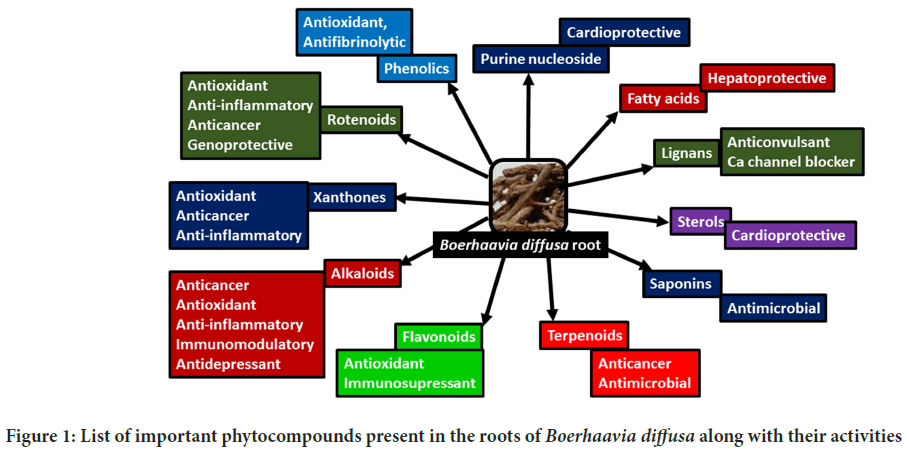
Figure 1: List of important phytocompounds present in the roots of Boerhaavia diffusa along with their activities
Figure 2: List of important phytocompounds present in the leaves of Boerhaavia diffusa along with their activities
Figure 3: Pharmacological activities of Boerhaavia diffusa
Several experiments were conducted worldwide on BD to correlate the presence of diverse phytocompounds with its bioactive potentials, which are summarized below. The in vivo/ex vivo and in vitro experiments conducted on BD extracts between the year 2000 to 2020.
Discussion
There are maximum number of reports for the antidiabetic and hypoglycemic effects of BD (12), followed by renoprotective/diuretic, anticancer, antiproliferative, anti-inflammatory activities (7), cardioprotective, hepatoprotective (5), hypolipidemic (4), immunomodulatory (3), followed by antistress/adaptogenic, antiasthmatic and effect on reproductive organs (2), whereas for wound healing, anticonvulsant, antiarthritic, antiulcer/ antacid, spasmolytic and anticataract activities, there is only one publication. There are 10 publications on antimicrobial activities, out of which 8 belong to antibacterial category and one each for antifungal and antimalarial activities, which are listed in Table 1. The most important pharmacological activities of different extracts of BD are represented in Figure 4. In recent years, the number of diabetic people is increasing at an alarming rate, worldwide especially in India due to life style changes, lack of physical exercise, work pressure, increasing stress, junk food practices and increasing childhood obesity. Nutraceutics or herbal therapeutics like BD could be taken as a dietary supplement to reduce such metabolic disorder. BD has been reported to have excellent antidiabetic activity by regulating and optimizing the biochemical parameters in different experimentally induced diabetic models. Therefore, the possible mechanism of its antidiabetic activity is presented in Figure 5. However, more clinical trials and evidence based intensive investigations are needed to validate its efficacy in human system.
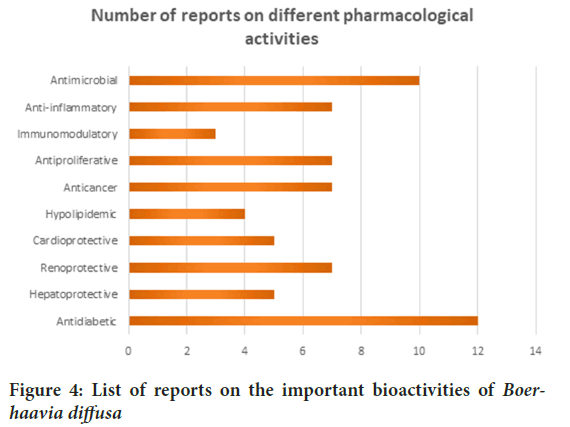
Figure 4: List of reports on the important bioactivities of Boerhaavia diffusa
Figure 5: Probable mechanism of action of the antidiabetic activity of Boerhaavia diffusa
Toxicity studies
Acute and sub-chronic toxicity of aqueous extract of BD leaves were inves-tigated in both mouse and rat model. In both the species, LD50 of aqueous extract of BD leaves was found to be more than 2000 mg/kg (p.o). Extract administered group had progressive increase in body weight and also had an increase in food and water intake. There was no significant difference of liver enzymes, haematological parameters and relative organ weights between the control and test groups, which proves the non-toxic effect of BD extract on mammalian system (Orisakwe OE, et al., 2003). In another study, Karwasra R, et al., 2016 reported the No-Observed Adverse Effect Level (NOAEL) of BD root extract was 1000 mg/kg in Wistar rats. The ethanol extract of BD (250 mg/kg, p.o.) was administered daily to the pregnant albino rats during the whole period of their gestation. It was observed that ethanol extract of BD did not induce teratogenic effect as the litter size and the survival rate of fetuses remained unchanged with respect to control group. Further, there was no fetal anomaly in BD treated rats (Singh A, et al., 1991).
Clinical trials of BD
Oral intake of dried BD root powder made the adults or children worm free, who were suffering from helminth infection, within five days (Singh RH and Udupa KN, 1972). A clinical trial was conducted on 50 patients, newly diagnosed with pulmonary tuberculosis to prove the efficacy of BD as an adjuvant to chemotherapy. BD treated group had faster clinical recovery rate than the control. 80% of the BD treated patients were relieved from cough as compared to 52% in the control group in 4 weeks and similarly, 88% of the patients in the treated group were afebrile in 4 weeks as compared to 60% of control. In just 6 weeks, BD treated group were relieved of fever whereas, in control group it was 8 weeks. The mean weight gain was higher in the treated group and also the rate of sputum conversion was significantly faster in the BD treated group than the control group (Kant S, et al., 2001). Aqueous extract of BD whole plant significantly reduced the osmotic fragility of erythrocyte in polycystic End-Stage Renal Disease (ESRD) patients due to alteration of erythrocyte membrane composition or its effect on the intracellular sodium and improvement of oxidative stress (Sathyapriya K, et al., 2009). In a clinical trial, patients having diabetic nephropathy (Type-I or Type-II) with proteinuria (>500 mg/ day), serum Cr (>5 mg/dl) were divided into 2 groups and observed for 6 months with monthly clinical examination. There were 14 and 11 patients in group I and group II, respectively at the end of the trial. The patients in group-I were aged from 40 to 70 years with mean age (60.78 ± 6.37 year) and 45 to 73 years (mean 60.27 ± 9.00 year) for group-II. All patients were clinically examined for hematological, biochemical and urine parameter. Patients had symptoms of oedema, anorexia, weakness and vomiting. BD treatment for six months, decreased 24 h urine protein excretion, but it was not statistically significant. However, Ramipril (standard drug) reduced 24 h urine protein excretion significantly (Singh RG, et al., 2010).
BD is reported to have multiple and multifunctional pharmacological activities by different investigators, which include antibacterial, antifungal, antiparasitic, antidiabetic, hepatoprotective, cardioprotective, renoprotective, anticancer, anti-inflammatory and antifertility activities etc. Though there are several reports on the pharmacological properties of BD, most of them are inconclusive regarding the molecular action of the therapeutic phytocompounds in preventing or protecting against a pathogen or disease. Therefore, clinical trials and advance studies can be further undertaken to decipher the molecular action of the isolated and unexplored secondary metabolites present in BD against different diseases.
Conclusion and Future Perspectives
BD is reported to have multiple and multifunctional pharmacological activities by different investigators, which include antibacterial, antifungal, antiparasitic, antidiabetic, hepatoprotective, cardioprotective, renoprotective, anticancer, anti-inflammatory and antifertility activities etc. Though there are several reports on the pharmacological properties of BD, most of them are inconclusive regarding the molecular action of the therapeutic phytocompounds in preventing or protecting against a pathogen or disease. Therefore, clinical trials and advance studies can be further undertaken to decipher the molecular action of the isolated and unexplored secondary metabolites present in BD against different diseases.
Author Contributions
Conceptualization: SD, SKB; investigation: SD, BMS; data collection: SD, BMS, SKB; writing and original draft preparation-SD, BMS, SKB and writing-review and editing: SD, SKB. All authors have read and agreed to the published version of the manuscript.
Acknowledgements
The authors express their sincere gratitude to all the researchers and publishers, whose valuable work is cited in this review.
References
- Wahi AK, Agrawal VK, Gupta RC. Phytochemical and pharmacological studies on Boerhavia diffusa Linn. (Punarnava) alkaloids. Natl Acad Sci Lett. 1997; 20: 119-123.
- Cadet JL. Free radical mechanisms in the central nervous system: An overview. Int J Neurosci. 1988; 40(1-2): 13-18.
[Crossref] [Google Scholar] [Pubmed]
- Demopoulos HB, Flamm ES, Pietronigro DD, Seligman ML. The free radical pathology and the microcirculation in the major central nervous system disorders. Acta Physiol Scand. 1980; 110(492): 91-119.
[Google Scholar] [Pubmed]
- Nadkarni K. Indian Materia Medica. Popular Prakashan. 1976; 1: 799.
- Agrawal B, Das S, Pandey A. Boerhaavia diffusa Linn: A review on its phytochemical and pharmacological profile. Asian J Appl Sci. 2011; 4(7): 663-684.
- Bhowmik D, Kumar KS, Srivastava S, Paswan S, Dutta AS. Traditional Indian herbs Punarnava and its medicinal importance. J Pharmacognosy Phytochem. 2012; 1(1): 52-57.
- Mishra S, Aeri V, Gaur PK, Jachak SM. Phytochemical, therapeutic, and ethnopharmacological overview for a traditionally important herb: Boerhavia diffusa Linn. Biomed Res Int. 2014.
[Crossref] [Google Scholar] [Pubmed]
- Samy RP, Ignacimuthu S, Raja DP. Preliminary screening of ethnomedicinal plants from India. J Ethnopharmacol. 1999; 66(2): 235-240.
[Crossref] [Google Scholar] [Pubmed]
- Gopal H, Vasanth S, Mebel JH. Anti bacterials from Boerhaavia diffusa. Anc Sci Life. 1999; 18(3-4): 254.
[Google Scholar] [Pubmed]
- Umamaheswari A, Nuni A, Shreevidya R. Evaluation of antibacterial activity of Boerhaavia diffusa L. leaves. Int J Green Pharm. 2010; 4(2).
- Apu AS, Liza MS, Jamaluddin AT, Howlader MA, Saha RK, Rizwan F, et al. Phytochemical screening and in vitro bioactivities of the extracts of aerial part of Boerhavia diffusa Linn. Asian Pac J Trop Biomed. 2012; 2(9): 673-678.
[Crossref] [Google Scholar] [Pubmed]
- Majgaine S, Verma DL. Antibacterial activity of Boerhaavia diffusa L.(Punarnava) on certain bacteria. IOSR J Pharm. 2017; 7(1): 01-13.
- Bai L, Goel P, Jhambh R, Preeti. Ameliorative potential of polyherbal immunomodulator preparation in dogs with canine monocytic ehrlichiosis. J Entomol Zool Studies. 2019; 7(1): 1305-1310.
- Agrawal A, Srivastava S, Srivastava MM. Antifungal activity of Boerhavia diffusa against some dermatophytic species of Microsporum. Hindustan Antibiot Bull. 2003; 45(1-4): 1-4.
[Google Scholar] [Pubmed]
- Agrawal A, Srivastava S, Srivastava JN, Srivastava MM. Inhibitory effect of the plant Boerhavia diffusa l. against the dermatophytic fungus Microsporum fulvum. Journal of environmental biology. 2004; 25(3): 307-311. [Crossref]
[Google Scholar] [Pubmed]
- Adefokun DI, Iwalewa EO, Omisore NO, Obuotor E, Idowu IJ. The antimalarial effect and mechanism of action of methanolic root extract of Boerhaavia diffusa in mice. Br J Pharm Res. 2015; 8(2): 1-4.
- Kaur S, Bhardwaj K, Sachdeva H. Antileishmanial efficacy of Boerhaavia diffusa L. and Ocimum sanctum L. against experimental visceral leishmaniasis. Indian J Exp Biol. 2015; 53(8): 522-529.
[Google Scholar] [Pubmed]
- Girish HV, Satish S. Antibacterial activity of important medicinal plants on human pathogenic bacteria-a comparative analysis. World Appl Sci J. 2008; 5(3): 267-271.
- Sangameswaran B, Balakrishnan N, Bhaskar VH, Jayakar B. Anti-inflammatory and anti-bacterial activity of leaves of Boerhavia diffusa L. Pharmacogn Mag. 2008; 65-68.
- Akinnibosun FI, Akinnibosun HA, Ogedegbe D. Investigation on the antibacterial activity of the aqueous and ethanolic extracts of the leaves of Boerhavia diffusa L. Sci World J. 2009; 4(2).
- Wagh SH, Vidhale NN. Antimicrobial efficacy of Boerhaavia diffusa against some human pathogenic bacteria and fungi. Biosci Biotechnol Res Asia. 2010; 7(1): 267-272.
- Ramachandra YL, Ashajyothi C, Rai P. In vitro antibacterial potential of Boerhaavia diffusa. Int J Adv Pharm Biol Chem. 2012; 1(3): 420-424.
- Rao PP. Ophthalmic uses of Boerhaavia diffusa L.(Punarnava): Review. Int J Herbal Med. 2016; 4(2): 5-9.
- Orisakwe OE, Afonne OJ, Chude MA, Obi E, Dioka CE. Sub-chronic toxicity studies of the aqueous extract of Boerhavia diffusa leaves. J Health Sci. 2003; 49(6): 444-447.
- Karwasra R, Kalra P, Nag TC, Gupta YK, Singh S, Panwar A. Safety assessment and attenuation of cisplatin induced nephrotoxicity by tuberous roots of Boerhaavia diffusa. Regul Toxicol Pharmacol. 2016; 81: 341-352.
[Crossref] [Google Scholar] [Pubmed]
- Singh A, Singh RG, Singh RH, Mishra N, Singh N. An experimental evaluation of possible teratogenic potential in Boerhaavia diffusa in Albino rats. Planta Med. 1991; 57(04): 315-316.
[Crossref] [Google Scholar] [Pubmed]
- Singh RH, Udupa KN. Studies on the Indian indigenous drug Punarnava (Boerhaavia diffusa L.) Part IV: Preliminary controlled clinical trial in nephrotic syndrome. J Res Indian Med. 1972; 7(3): 28-33.
- Kant S, Agnihotri MS, Dixit KS. Clinical evaluation of Boerhaavia diffusa as an adjuvant in the treatment of pulmonary tuberculosis. Phytomedica. 2001; 2(1): 89-94.
- Sathyapriya K, Vijayachandrika V, Parameswari CS. Antioxidant status in polycystic end-staged renal diseased patients and antihemolytic effect of Boerhaavia diffusa. Ind J Biochem Biophys. 2009; 46(3): 269-272.
- Singh RG, Kumar G, Singh SK, Tripathi YB, Singh RH, Usha. Evaluation of antiproteinuric and renoprotective effect of Punarnava (Boerhavia diffusa Linn.) in diabetic nephropathy. J Res Educ Ind Med. 2010; 16(2): 45-48.
Author Info
Sarita Das1*, Biswa Mohan Sahoo2 and Subrat Kumar Bhattamisra32Department of Pharmaceutics, Roland Institute of Pharmaceutical Sciences, Odisha, India
3Department of Pharmaceutical Technology, School of Medical Sciences, Adamas University, West Bengal, India
Citation: Das S: Vivid Phytochemical and Pharmacological Evaluations of Boerhaavia diffusa L.: An Omnipotent Natural Healer
Received: 24-Jul-2023 Accepted: 18-Aug-2023 Published: 25-Aug-2023, DOI: 10.31858/0975-8453.14.8.514-519
Copyright: This is an open access article distributed under the terms of the Creative Commons Attribution License, which permits unrestricted use, distribution, and reproduction in any medium, provided the original work is properly cited.
ARTICLE TOOLS
- Dental Development between Assisted Reproductive Therapy (Art) and Natural Conceived Children: A Comparative Pilot Study Norzaiti Mohd Kenali, Naimah Hasanah Mohd Fathil, Norbasyirah Bohari, Ahmad Faisal Ismail, Roszaman Ramli SRP. 2020; 11(1): 01-06 » doi: 10.5530/srp.2020.1.01
- Psychometric properties of the World Health Organization Quality of life instrument, short form: Validity in the Vietnamese healthcare context Trung Quang Vo*, Bao Tran Thuy Tran, Ngan Thuy Nguyen, Tram ThiHuyen Nguyen, Thuy Phan Chung Tran SRP. 2020; 11(1): 14-22 » doi: 10.5530/srp.2019.1.3
- A Review of Pharmacoeconomics: the key to “Healthcare for All” Hasamnis AA, Patil SS, Shaik Imam, Narendiran K SRP. 2019; 10(1): s40-s42 » doi: 10.5530/srp.2019.1s.21
- Deuterium Depleted Water as an Adjuvant in Treatment of Cancer Anton Syroeshkin, Olga Levitskaya, Elena Uspenskaya, Tatiana Pleteneva, Daria Romaykina, Daria Ermakova SRP. 2019; 10(1): 112-117 » doi: 10.5530/srp.2019.1.19
- Dental Development between Assisted Reproductive Therapy (Art) and Natural Conceived Children: A Comparative Pilot Study Norzaiti Mohd Kenali, Naimah Hasanah Mohd Fathil, Norbasyirah Bohari, Ahmad Faisal Ismail, Roszaman Ramli SRP. 2020; 11(1): 01-06 » doi: 10.5530/srp.2020.1.01
- Manilkara zapota (L.) Royen Fruit Peel: A Phytochemical and Pharmacological Review Karle Pravin P, Dhawale Shashikant C SRP. 2019; 10(1): 11-14 » doi: 0.5530/srp.2019.1.2
- Pharmacognostic and Phytopharmacological Overview on Bombax ceiba Pankaj Haribhau Chaudhary, Mukund Ganeshrao Tawar SRP. 2019; 10(1): 20-25 » doi: 10.5530/srp.2019.1.4
- A Review of Pharmacoeconomics: the key to “Healthcare for All” Hasamnis AA, Patil SS, Shaik Imam, Narendiran K SRP. 2019; 10(1): s40-s42 » doi: 10.5530/srp.2019.1s.21
- A Prospective Review on Phyto-Pharmacological Aspects of Andrographis paniculata Govindraj Akilandeswari, Arumugam Vijaya Anand, Palanisamy Sampathkumar, Puthamohan Vinayaga Moorthi, Basavaraju Preethi SRP. 2019; 10(1): 15-19 » doi: 10.5530/srp.2019.1.3







